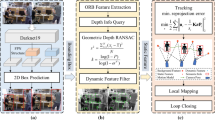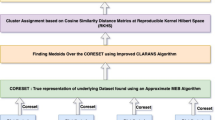Abstract
Sensor node localization is one of research hotspots in the applications of wireless sensor networks (WSNs) field. In recent years, many scholars proposed some localization algorithms based on machine learning, especially support vector machine (SVM). Localization algorithms based on SVM have good performance without pairwise distance measurements and special assisting devices. But if detection area is too wide and the scale of wireless sensor network is too large, the each sensor node needs to be classified many times to locate by SVMs, and the location time is too long. It is not suitable for the places of high real-time requirements. To solve this problem, a localization algorithm based on fast-SVM for large scale WSNs is proposed in this paper. The proposed fast-SVM constructs the minimum spanning by introducing the similarity measure and divided the support vectors into groups according to the maximum similarity in feature space. Each group support vectors is replaced by linear combination of “determinant factor” and “adjusting factor” which are decided by similarity. Because the support vectors are simplified by the fast-SVM, the speed of classification is evidently improved. Through the simulations, the performance of localization based on fast-SVM is evaluated. The results prove that the localization time is reduce about 48 % than existing localization algorithm based on SVM, and loss of the localization precision is very small. Moreover, fast-SVM localization algorithm also addresses the border problem and coverage hole problem effectively. Finally, the limitation of the proposed localization algorithm is discussed and future work is present.










Similar content being viewed by others
References
Liu, H., Xiong, S., & Chen, Q. (2009). Localization in wireless sensor network based on multi-class support vector machines. In Proceedings of 5th international conference on wireless communications, networking and mobile computing 2009 (pp. 4–7), Beijing, China, Sept 24–26.
Krishnan, A. M., & Kumar, P. G. (2015). An effective clustering approach with data aggregation using multiple mobile sinks for heterogeneous WSN. Wireless Personal Communications, 2015, 1–12.
Rahman, M., & Sampalli, S. (2015). An efficient pairwise and group key management protocol for wireless sensor network. Wireless Personal Communications, 84(3), 2035–2053.
Suryadevara, N. K., Mukhopadhyay, S. C., Kelly, S. D. T., & Gill, S. P. S. (2014). WSN-based smart sensors and actuator for power management in intelligent buildings. IEEE/ASME Transactions on Mechatronics, 20(2), 564–571.
Badiamelis, R., Ruizgarcia, L., Garciahierro, J., & Villalba, J. I. (2015). Refrigerated fruit storage monitoring combining two different wireless sensing technologies: RFID and WSN. Sensors, 15(3), 4781–4795.
Li, S., Wang, X., Zhao, S., Wang, J., & Li, L. (2014). Local semidefinite programming-based node localization system for wireless sensor network applications. IEEE Systems Journal, 8(3), 879–888.
Yan, Y., Wang, H., Shen, X. H., He, K., & Zhong, X. H. (2015). TDOA-based source collaborative localization via semidefinite relaxation in sensor networks. International Journal of Distributed Sensor Networks, 2015, 1–16.
Ding, Y., Yang, D., & Han, G. (2014). Multidimensional scaling-based localization algorithm for wireless sensor network with geometric correction. Journal of Networks, 9(3), 582–587.
Morral, G., & Bianchi, P. (2015). Distributed on-line multidimensional scaling for self-localization in wireless sensor networks. Signal Processing, 120, 88–98.
Lee, S. W., Lee, D. Y., & Lee, C. W. (2010). An improved DV-Hop localization algorithm in ad hoc networks. In Proceedings of 4th international conference on ubiquitous information management and communication ICUIMC, Suwon, Korea (pp. 464–470), Jan 14–15.
Han, G. J., Zhang, C. Y., Liu, T. Q., & Shu, L. (2016). A multi-anchor nodes collaborative localization algorithm for underwater acoustic sensor networks. Wireless Communications and Mobile Computing, 16(6), 682–702.
Zhou, C. Y., Xu, T., & Dong, H. R. (2015). Distributed locating algorithm MDS-MAP (LF) based on low-frequency signal. Computer Science and Information Systems, 12(4), 1289–1305.
Fan, J., Zhang, B. H., & Dai, G. J. (2015). D3D-MDS: A distributed 3D localization scheme for an irregular wireless sensor network using multidimensional scaling. International Journal of Distributed Sensor Networks, 7, 1–10.
Lee, H., Lee, S., Kim, Y., & Chong, H. (2009). Grouping multi-duolateration localization using partial space information for indoor wireless sensor networks. IEEE Transactions on Consumer Electronics, 55(4), 1950–1958.
Wang, F., Wang, C., Wang, Z. Z., & Zhang, X. Y. (2015). A hybrid algorithm of GA+ simplex method in the WSN localization. International Journal of Distributed Sensor Networks, 2015(1), 1–9.
Pan, J. J., Kwok, J. T., Yang, Q., & Chen, Y. (2006). Multidimensional vector regression for accurate and low-cost location estimation in pervasive computing. IEEE Transactions on Knowledge and Data Engineering, 18(9), 1181–1193.
Xu, J., Qian, H., Dai, H., & Zhu, J. (2014). Wireless sensor network localization based on a mobile beacon and TSVM. Cybernetics & Information Technologies, 14(5), 98–107.
Kim, W., Park, J., Kim, H. J., & Chan, G. P. (2014). A multi-class classification approach for target localization in wireless sensor networks. Journal of Mechanical Science and Technology, 28(1), 323–329.
Safa, H. (2014). A novel localization algorithm for large scale wireless sensor networks. Computer Communications, 45(3), 32–46.
Mao, K., Fan, C., Fei, Y., Peng, W., & Chen, Q. (2014). Node localization algorithm in wireless sensor networks based on svm. Journal of Computer Research & Development, 51(11), 2427–2436.
Huan, R., Chen, Q., Mao, K., & Pan, Y. (2010). A three-dimension localization algorithm for wireless sensor network nodes based on SVM. In Proceedings of 1st international conference on green circuits and systems (pp. 651–654), Shanghai, China, June 21–23.
Abe, S. (2015). Fuzzy support vector machines for multilabel classification. Pattern Recognition, 48(6), 2110–2117.
Yuan, D. (2013). Svm decision-tree multi-classification strategy via electromagnetism-like mechanism. Journal of Xidian University, 41(6), 83–88.
Shu, S., Ren, L., Ding, Y., & Hao, K. (2014). SVM optimization algorithm based on dynamic clustering and ensemble learning for large scale dataset. In Proceedings of IEEE international conference on systems, man and cybernetics—SMC (pp. 2278–2283), San Diego, CA, USA, October 5–8.
Mao, Q. H., Ma, H. W., & Zhang, X. H. (2014). SVM classification model parameters optimized by improved genetic algorithm. Advanced Materials Research, 889–890, 617–621.
Djouama, A., Lim, M. S., & Ettoumi, F. Y. (2014). Channel estimation in long term evolution uplink using minimum mean square error-support vector regression. Wireless Personal Communications, 79(3), 2291–2304.
Xuan, J., Luo, X., Zhang, G., Lu, J., & Xu, Z. (2016). Uncertainty analysis for the keyword system of web events. IEEE Transactions on Systems, Man, and Cybernetics: Systems, 46(6), 829–842.
Xu, Z., et al. (2015). Knowle: a semantic link network based system for organizing large scale online news events. Future Generation Computer Systems, 43–44, 40–50.
Xu, Z., Liu, Y., Yen, N., Mei, L., Luo, X., Wei, X., et al. (2016). Crowdsourcing based description of urban emergency events using social media big data. IEEE Transactions on Cloud Computing,. doi:10.1109/TCC.2016.2517638.
Xu, Z., Liu, Y., Xuan, J., Chen, H., & Mei, L. (2015). Crowdsourcing based social media data analysis of urban emergency events. Multimedia Tools and Applications,. doi:10.1007/s11042-015-2731-1.
Acknowledgments
This work is supported by the National Natural Science Foundation of China under Grant No. 61401083 and the Natural Science Foundation for Young Scholars of Hebei Province of China under Grant No. F2014501139.
Author information
Authors and Affiliations
Corresponding author
Rights and permissions
About this article
Cite this article
Zhu, F., Wei, J. Localization Algorithm for Large Scale Wireless Sensor Networks Based on Fast-SVM. Wireless Pers Commun 95, 1859–1875 (2017). https://doi.org/10.1007/s11277-016-3665-2
Published:
Issue Date:
DOI: https://doi.org/10.1007/s11277-016-3665-2




